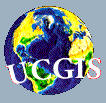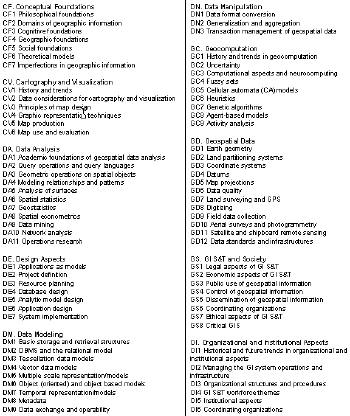 As Directions
Magazine regularly points out,
geospatial technologies are used in many ways in many different fields.
This is true in higher education as well.Numerous academic disciplines
are involved in GIS-related research, education and training.At the
same time, however, there is evidence that a distinct field of study
focused on geographic information science and technology (GI S&T)
is emerging.One sign is the appearance of specialized certificate and
degree programs offered by accredited U.S.colleges and universities.
You can now earn a Certificate of Achievement in GIS, a BSc in
Geographic Information Science, a MSc in GIS or Master of GIS, and even
a PhD in Geospatial Information Sciences.What should students learn in
these programs?
As Directions
Magazine regularly points out,
geospatial technologies are used in many ways in many different fields.
This is true in higher education as well.Numerous academic disciplines
are involved in GIS-related research, education and training.At the
same time, however, there is evidence that a distinct field of study
focused on geographic information science and technology (GI S&T)
is emerging.One sign is the appearance of specialized certificate and
degree programs offered by accredited U.S.colleges and universities.
You can now earn a Certificate of Achievement in GIS, a BSc in
Geographic Information Science, a MSc in GIS or Master of GIS, and even
a PhD in Geospatial Information Sciences.What should students learn in
these programs?If GI S&T qualifies as a discrete field of study, the geospatial community ought to be able to identify the subject matter that pertains uniquely to our field.Textbooks and academic curricula approximate this, but tend to reflect the interests and specialties of particular authors or faculties.Related fields, including Computer Science, Information Science, Management Information System, and Project Management, have done better.Each of these has collectively compiled and published a "Body of Knowledge" that serves as a formal inventory of the intellectual content of their field.Now, our field is doing the same, and your input is invited.
You can download a draft version of the GI S&T Body of Knowledge 2006 at the University Consortium for Geographic Information Science (UCGIS) website. The Body of Knowledge is one element of UCGIS' Model Curricula project, which began in 1998 with a vision of national-scale curricular reform of GI S&T undergraduate education.The UCGIS site also provides a discussion forum at which you can post questions, comments and suggestions for the editorial team which, in consultation with a 54-member advisor board, is shepherding the Body of Knowledge toward publication.The public comment period will continue through January 31, 2006, after which editors will deliver the manuscript to the publisher.Later revised editions are expected to follow in response to the dynamic nature of the field.
Contents of the GI S&T Body of Knowledge 2006
The GI S&T Body of Knowledge 2006 includes six sections. The first section defines the GI S&T field in terms of three subfields - Geographic Information Science, Geospatial Technology, and Applications - and describes relationships to allied fields such as Computer Science and Information Science.Section II, Why is a GI S&T Body of Knowledge Needed?, recounts the workforce issues that drive concerns about GI S&T education and training, examines the "education infrastructure" that is responsible for addressing workforce needs in the U.S., and identifies potential benefits of a Body of Knowledge.Section III situates the Model Curricula project and the Body of Knowledge within the historical context of GI S&T curriculum development efforts in the U.S..Section IV, How was the Body of Knowledge Developed?, describes the Model Curricula vision and explains how the GI S&T Body of Knowledge has evolved.Section V presents the 10 knowledge areas that comprise the Body of Knowledge itself.Finally, Section VI speculates on the future evolution of the GI S&T domain and the GI S&T education infrastructure, and suggests a timetable for future Model Curricula activities.
The 10 knowledge areas, along with 79 subsidiary units, are outlined below.Not shown are the more than 350 individual topics that elaborate the units in greater detail.Each unit is defined in terms of one or more formal educational objectives.For example, unit DA3: Geometric Operations on Spatial Objects, includes topic DA3-1: Spatial Queries, which is defined in terms of three educational objectives: (1) construct a spatial query to extract all point objects that fall within a polygon; (2) compare and contrast attribute query and spatial query; and (3) state questions that can be solved by selecting features based on location or spatial relationships.Not included are relevant topics listed in the Bodies of Knowledge of allied fields.Neither are crucial interpersonal skills or business knowledge included, although they obviously are characteristics of successful geospatial professionals.
The 10 knowledge areas and 79 units that comprise the UCGIS GI S&T Body of Knowledge 2006.Not shown are the more than 350 individual topics that elaborate the units in greater detail.
Using the GI S&T Body of Knowledge 2006
Although it was conceived originally as a basis for undergraduate curriculum planning, we expect the Body of Knowledge to be useful to individuals and organizations in many different ways.The GI S&T Body of Knowledge 2006 will help:
- Job seekers, who wish to assess and communicate their experience and skills more clearly and accurately.
- Employers, who need to identify knowledge and skill requirements for their employees, and who need to assess applicants' competencies.
- Geospatial professionals, who wish to better characterize the tasks they need to complete, to more easily locate resources (e.g., software from different vendors) that best meet their needs, to plan continuing professional development strategies.
- Certification bodies, which need to determine the set of knowledge and skills that make someone a novice or expert in particular areas, and to create standard means of evaluating their applicants' competencies.
- Accrediting bodies, which seek to evaluate the core needs of education resources of different types (including undergraduate, graduate, professional and informal education).
- Education and training providers (including colleges, universities, professional trainers and software vendors), who need to plan, implement, assess, and revise their programs.
- Students, who wish to benchmark their educational achievements, or to identify programs and courses that provide education in their areas of interest.
- Authors of professional and academic publications (including magazines, books and textbooks), who will benefit from a standard foundation and terminology on which to can frame their own ideas.
- GIScience researchers, whose work will extend the current Body of Knowledge.
- The geospatial profession, which will gain greater recognition as a distinct and coherent field.
The Body of Knowledge is a community effort.Your input is genuinely welcomed.You are invited to download the draft document, post comments in the discussion forum, or to suggest specific changes by editing the draft document and forwarding it to the editors. Comments received by January 31 will be considered.Contributors should address the following review criteria:
- Do the knowledge areas encompass the breadth of the GI S&T field?
- Do the topics within the knowledge areas adequately reflect the depth of the GI S&T domain?
- Identify what you consider to be the core units in one or more knowledge areas.Core units are those collections of topics about which every graduate of a degree or certificate program in GI S&T ought to be able to demonstrate competence.
- Identify missing or ill-defined topics in one or more knowledge areas.
- Identify missing cross-references - i.e. topics that appear in two or more knowledge areas, or topics in two or more knowledge areas that are related.
- Suggest revised unit and/or knowledge area descriptions as appropriate.
